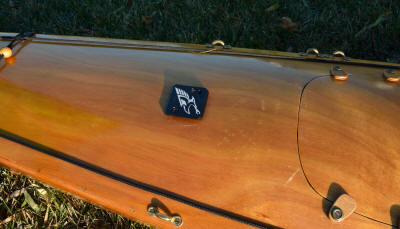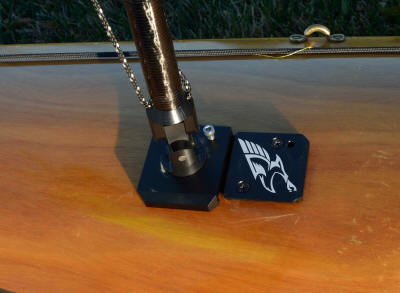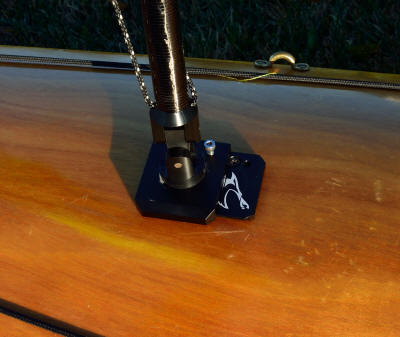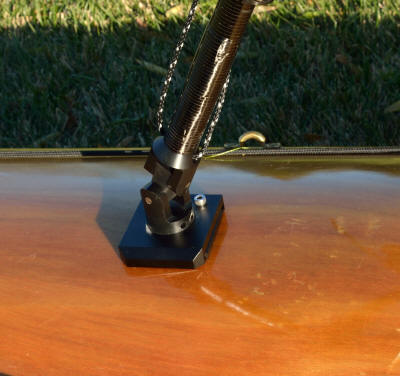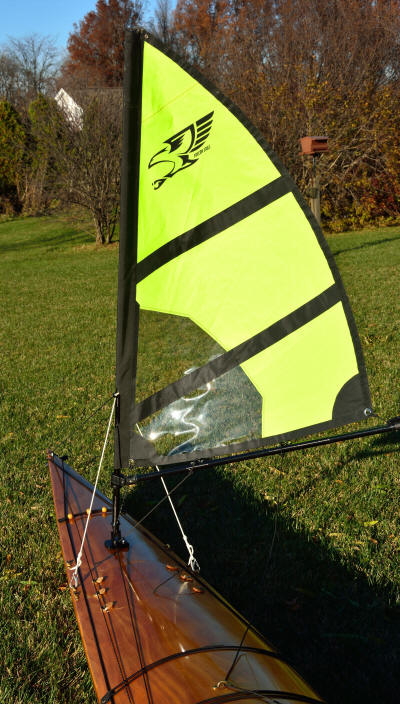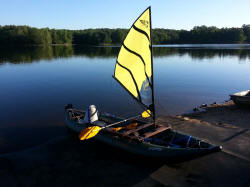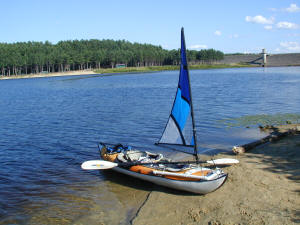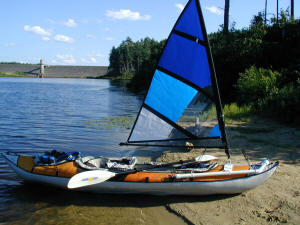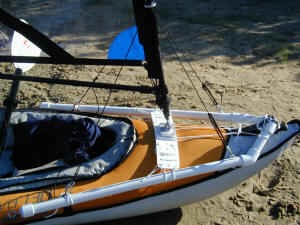Frequently Asked Questions About Kayak Sailing and Falcon Sails
Why would I put a sail on my kayak or canoe?
The number one reason is kayak and canoe sailing is a blast! There are so many reasons to put a sail on your canoe or kayak, we have dedicated a full page to this issue. Take a look at our why kayak sail or canoe sail page
Is kayak sailing fun?
Kayak sailing is a blast! Most people who buy a kayak sail evolve into almost always taking their sail every time they paddle, and start to look for wind rather than try to avoid wind.
Is kayak sailing hard to do?
The short answer is kayak sailing is easy to do. Anybody that is comfortable in a canoe or kayak will catch on to sailing a paddle craft in no time! Compared to windsurfing, it's a breeze ! As the wind increases, it becomes more challenging. Most people will find paddle sailing in light wind very easy to do with just a little practice.
What if I have no sailing experience or sailing knowledge?
Most new kayak sailors have zero sailing experience before they start kayak sailing, and they still do fine.
Anybody who is comfortable in a canoe or kayak will catch on to sailing a paddle craft in no time! Most people quickly go for the intuitive down wind run, and then start to experiment with going off the straight down wind run. In reasonable conditions, a non-sailor can be sailing across the wind within the first 10 minutes of their first paddle sail. That is a truly eye opening experience!
The owner of Falcon Sails says he would much rather take out a kayaker that is a non-sailor, than a sailor that is a non-kayaker, for a first time paddle sail.
Traditional sailing experience provides a small benefit in terms of knowing the lingo and fine tune adjustments, but it is not a requirement. An experienced paddle sailor with no traditional sailing experience, will do circles around a kayaker with traditional sailing experience and no paddle sailing experience. An experienced paddler with no sailing experience of any kind, will even do circles around a very experienced traditional sailor with no paddling experience.
Before you start, take 5 minutes to make sure you know how to quickly lower your Falcon Sail, so you can fully depower at any time. There is some information on that below.
What kind of kayak or canoe can be used for paddle sailing?
Any canoe or kayak can be used for paddle sailing. Wide, narrow, short, long, sit on tops, sit insides, sea kayak, rec kayaks, canoes, plastic, wood, and fiberglass, are all fine. Our kayak sail kits can even be installed on a row boat. Any plastic, fiberglass or wood boat will rig and sail nicely.
What kayaks and canoes will a falcon sail kit install on?
We have seen Falcon Sails installed on every kind of kayak we can think of except skin on frame kayaks. Including plastic sea kayaks, fiberglass sea kayaks, wood sea kayaks, recreational kayaks, aluminum canoes, fiberglass canoes, inflatable kayaks. We even have seen a Falcon Sail installed on a gas powered kayak. If you have a kayak that is not a skin on frame you can install a Falcon Sail on it. A creative owner of a skin on frame kayak could also install a sail. It would just take some extra thinking and securing a rigid mast on a flexible deck and hull.
What are the best kayaks and canoes for a falcon sail kit?
All kayaks sail surprisingly well, if you have a good sail rig. The only exception to this general rule are some inflatable kayaks sail poorly and are hard to rig. In general inflatable kayaks are handy if you have some transportation or storage issues, but they have limitations with our without a sail. With the exception of inflatable kayaks, what ever kayak you own and like, is a good kayak for kayak sailing, if you have a good sail rig for it. Falcon Sails can make a rigging kit with everything you need for a fast and solid rigging job for any plastic, fiberglass, wood, or other composite kayak. If you like recreational kayaks, then that is the boat to use for kayak sailing. If you like sea kayaks, sail with a sea kayak. Do not change kayaks to find one that is ideal for kayak sailing. As long as it not an inflatable, your kayak will be good for kayak sailing. If you happen to be choosing a kayak, specifically for kayak sailing and nothing else, typically the short recreational kayaks sail very nicely. They are especially good for people that are new to kayaking. They are easy to set a course, and stay on course. They sail up wind surprisingly well, and they are very stable. If a kayak has more contour to its hull, this is good as well, as it will increase the lateral resistance and ability to sail up wind. A sharp pointy bow entry has its advantages as well for increasing lateral resistance. These things are not critical at all, but will provide some minor benefits over a kayak without these features. lf you do not own a kayak yet and have no particular desires in the kayak you own, a shorter wider kayak is a lot easier to control than a long narrow kayak. If you are buying a new kayak it is best to get the kayak you like with, our without a sail. With a Falcon Sail, you can turn your kayak into a great sailing kayak.
Will your sails work on a boat other than a kayak?
Yes. They work great on canoes. They will even install nicely on a row boat or any other boat you would like an alternative or auxiliary form of propulsion.
How will a Falcon Sail work on a short wide recreational kayak or sit on top kayak ?
Short and wide Recreational (plus sit on tops) kayaks are the easiest kayaks to sail and control. They have the very best stability, are easier to turn and easier to keep on track. Recreational kayakers consistently report great paddle sailing experiences. We put this question in this list because there are so many pictures of sea kayaks with sails on our website. People may get the wrong idea that recreational and sit on top boats are not suitable for kayak sailing and that is not correct. Recreational boats make excellent sailing platforms. The owner of Falcon Sails, and most of his paddle sailing friends are sea kayakers, so most kayak sailing pictures on this website show sea kayaks with sails. In reality recreational kayaks probably sail nicer than sea kayaks do. The most important factor is, you should sail the kayak you like the most and are the most comfortable in, because, if it is a hard shell ( plastic, fiberglass, or wood ) kayak, it will rig and sail nicely.
How do I stay upright? Will I get knocked over when kayak or canoe sailing?
If you push your limits, you are going to increase your chances of being knocked over. If you stay in relatively calm situations where you feel comfortable, you can avoid being knocked over. Most non-paddlers think canoes and kayaks are prone to tipping over. Usually the first thing that comes to the mind of a non-paddle sailor that thinks about paddle sailing is tipping over. Just like a paddle craft can tip over a paddle craft with a sail can also tip. In practice, most paddlers who give kayak or canoe sailing a good try get past this concern quickly. And if you spend time paddle sailing you will learn it is easy to avoid being tipped over even in heavier winds. If you go to our home page you can see kayak sailing videos of paddlers in all kinds of conditions. If you go to YouTube you will find more kayak sailing videos than you can watch in a night and not see somebody tip over. Once you are under sail and you feel a the wind a level that may cause a tip, you counteract that by skimming your paddle on the surface of the water and it becomes a very effective outrigger. With a single mast style sail rig like all falcon kayak sails you can easily depower it by letting it wind vane / let the boom out. The most likely thing to cause you to tip over is going out in conditions that exceed your skills. If you take it easy until you figure things out you can avoid tipping over. Most paddlers find their limits and stay within them relatively quickly and avoid getting knocked over.
- Lean your weight upwind. This is the #1 way to stay upright! It does not take long to make this a 2nd nature reaction.
- Use your paddle as an outrigger. Once you are moving you can hold your paddle over the water and let it skim over the surface.
- When not moving, do not raise your sail in a position that all its force will push you over. Make sure the lines are loose so the boom can weather vane or raise the sail with your bow into the wind.
- Use good judgment. If you are not sure of your abilities, then paddle without a sail.
- Sail size selection. The more windy it is, the smaller the sail you should use. Once you get used to a big sail in moderate wind, you will hardly notice the effects of a small sail in moderate wind.
- Practice with your sail while sitting in your backyard and in low wind before you step up to big wind.
If I do get knocked over what do I do?
You recover just like you would if you get knocked over without the sail. Assuming you cannot roll your kayak )rolling is easily done by releasing the mast and rolling), and you do a wet exit you will recover in the following way.
- Secure the sail. i.e. put the sail down & secure it to the deck.
- Most people will do a paddle float re-entry, and some will do a re-enter and roll re-entry.
Before you go out for a paddle sail, assume the worse and make sure you know how to deal with whatever may happen. You should always have assisted and self rescue skills you have practiced and mastered in conditions more difficult than the conditions you are going out in. It is a good idea to get to know some kayakers that are more experienced than you are to learn from.
How do I steer while paddle sailing?
With a little trial and error you will find steering very easy to do. Most people master what they need to with steering without thinking a lot about it. It's pretty much the same as steering without a sail. The most efficient way to steer while kayak or canoe sailing is to use a forward paddle stroke. Steering with a forward stroke while paddle sailing is just like steering with a forward stroke when not paddle sailing. Your forward stroke will be more efficient if you use a sweep / sweeping stroke. Though a forward stroke / forward sweep stroke is all you need for steering here is a list of other options for steering.
- Lean downwind to turn upwind, lean upwind to turn downwind. This is a lot like turning a boat with out a sail by leaning, but much more effective. Leaning downwind reduces lateral force on the sail, and also increases downward force on the hull which increases lateral resistance at the bow. Leaning upwind increases lateral force on the sail, and also decreases downward force on the hull which reduces lateral resistance at the bow. In effect this significantly changes your trim which is discussed below.
- Lean forward to turn upwind lean back to turn downwind. This is not very powerful, but can be used to make stronger turns when using other methods.
- If you have a skeg on your kayak or canoe, put your skeg down to turn downwind, put your skeg up to turn upwind.
- Sweep strokes. A hard forward turning stroke is a great tool to use to steer your kayak. This will make you go even faster.
- Rudder strokes. You can use your paddle as a rudder to turn up or downwind.
- Loosen the sail ( let the sheet / boom control line out ) to turn upwind, tighten the sail ( pull the sheet / boom control line in ) to turn downwind.
- If you have a rudder use your rudder. Rudders are nice for lazy sailing but far from necessary. Rudders are not created equally. Contact us for rudder recommendations.
- Use a back stroke. This is the lest desirable way to turn but does work especially for turning downwind.
- If you happen to be ready for good size waves, you can turn down wave very easily with a sweep stroke as the bow is out of the water. You can easily turn up wind with a sweep stroke when the stern is out of the water or you are heading down a steep wave.
With practice, turning becomes very natural and you can use combinations
of the above methods to change the balance of your kayak to turn your boat.
The other issue related to steering is your boat trim. Trim
in this case relates to your boats tendency to stay on course, or turn into
the wind or turn downwind. When everything is ideal, your center of lateral
resistance below the water line, is matched with the center of lateral force
above the water line. When both are in the same place the boat tends
to stay on the course you have set. If your stern is heavy, your center
of lateral resistance will be back near the stern, and if your bow is heavy
your bow will tend to dig in more and move your center of lateral resistance
forward.
Trim is something that changes continually. With experience you will use some of the tricks to impact trim to your advantage. If you do not have a trim problem, or do not care to perfect your trim you can ignore these things.
- If you have a sail on your boat, and you are carrying gear of any kind, put what ever is convenient up front. If you are carrying a heavy load, put a little more weight in the front hatch than you would if you where just paddling. This weight up front will tend to move your center of lateral resistance forward as the bow will have a little more drag, and the stern a little less. In general you want weight skewed toward the front when paddle sailing. Just a little. Not by a significant amount.
- A skeg is a great tool for changing your center of lateral resistance. Its exactly what a skeg is designed to do. If your boat has pretty good balance / course holding ability, leave the skeg where it is. If your boat is tending to turn into the wind, put the skeg down a bit. If your kayak is turning down wind, put the skeg up a bit. In other words, if you want change the boats trim to be more up wind put the skeg up, if you want to change the boats trim to be more down wind, adjust the skeg down.
- Use your body to change your trim. This is mentioned above. When you lean forward you are moving your center of lateral resistance forward under the water line which will give you more of an up wind tendency. When you lean back, you are doing just the opposite and giving the boat a some down wind force.
- Use speed to your advantage. When you are moving fast the pressure on your bow creates a lot of resistance and your center of lateral resistance moves forward and thus the boat will tend to turn more into the wind. When you slow down the center of lateral resistance below the water line moves aft, and you will tend to go down wind more.
Do I need a rudder?
Do I need a skeg?
Just like rudders, skegs are not necessary for kayak sailing or canoe sailing. If you do not miss an adjustable skeg in your kayak when kayaking without a sail, you will not miss an adjustable skeg while kayak sailing. Though they can be nice to have on longer boats (15 feet or longer). Adjustable skegs can be used to change the tendency of your boat to weather cock or lee cock / turn upwind or downwind. All kayaks will tend to turn upwind on occasion and downwind on occasion. These tendencies can be neutralized by adjusting your skeg depth. Just as when you are no sail paddling, a adjustable skeg can be handy for steering. If you want to turn downwind put the skeg down, if you want to turn upwind put the skeg up. This will not necessarily turn your boat, but if used properly, a skeg can improve your kayaks tendency to react to your paddle strokes.
If you do not have a skeg, your boats tendency to weather or lee cock can be adjusted by shifting weight fore or aft in your boat and pulling the boom in tighter or looser. There are a lot of other techniques for adjusting your trim. A skeg adjustment is just one of the techniques to use. It does not take long to discover how to load your boat, lean and adjust your position fore and aft to make its turning tendency to be neutral or up wind or down wind depending on what you want to do at any given moment.
Are outriggers necessary?
Outriggers are not necessary. Falcon Kayak sails are oriented to normal kayaks, and do not need anything more than a kayak and a paddler to work. Falcon sails are made have the minimum effect on your every day paddling. To go kayak sailing all you need is a sail. You can use outriggers if you would like to use outriggers but are unnecessary. If you want a dedicated kayak sailing kayak with integrated outriggers they are available. They are expensive, and will not allow you to do the same kind of typical kayaking that paddlers do without outriggers. They take away a lot more than they give you, they are expensive, they slow you down, and make transporting your rig substantially more difficult.
If I mount my sail on the front of my boat will the bow be pushed downwind?
The short answer is, you can mount your sail far forward and not worry about your bow being pushed downwind. As a matter of fact the only good place to mount a sail on your kayak, is near the front of the boat.
Here is a detailed answer.Typically initial thoughts about a kayak sail being on the front of a kayak is that the bow will be pushed downwind. When a sail is rigged at the front of a nonmoving boat a simple assumption like that would be partially true. Once you start moving this initial assumption becomes less and less true and a non issue when you are moving at any decent speed. One of the major design goals of any kayak hull is to track in a straight line. When you make a kayak that will track, loads of lateral resistance naturally come with this design goal. This is extremely handy for sailing.
When kayak sailing, the only time your bow gets blown downwind is when you point your bow downwind. In actuality once a kayak being pushed by a sail, the bow tends to turn into the wind. This is due to water pressure on the entry point of the hull increasing as speed increases. Once a kayak is moving at any decent speed the pressure holding the bow from sliding sideways is significant, compared to the pressure at the stern (tail) of the kayak. In other words the bow has more lateral resistance than the stern, and the center of lateral resistance moves forward as you pick up speed. So the bow tends to hold its place solidly. All this makes the bow tend to turn into the wind. This is why all kayaks tendency to turn into the wind increases as you start moving faster. This is true with or without a sail. If you paddle on a windy day your bow tends to turn into the wind more and more the faster you go. This tendency becomes irritating at times, but it is very handy for kayak sailing when the best place to put the sail to allow for maximum freedom of paddling is near the bow.
A properly designed airfoil will produce forward propulsion as wind passes over it / convert lateral force to propulsion. A proper air foil shape will create much less lateral movement than you would think & a surprising amount of forward propulsion.
Another factor is, sails produce some downward force that further increases the resistance to the bow moving sideways. Additionally paddle sailors can increase the upwind tendency of a kayak by placing gear being carried in the front hatch of a kayak, or trim its tendency more downwind by putting weight in the rear hatch compartment. This is just a fine tuning practice any paddler should experiment with when going out in the wind with or without a sail.
This whole myth / tendency of some to believe a kayak hull will be blown downwind, has a lot of its roots in conventional sail boat mechanics. Sail boat hulls are quite different than kayak hulls. Strictly sail boat hulls are almost always made for maximum efficiency to spite almost all other factors. When the wind is light, drag has to be at an absolute minimum. In a kayak, there is always paddle power at hand, so maximum efficiency is not a goal to spite all other factors. A typical sail boat hull will move sideways and spin without a keel or centerboard and a large rudder. If you look at the bottom of a typical sail boat hull, it is obvious why a keel is necessary for keeping the boat from sliding sideways. Kayak hulls do not have near the tendency of a sail boat hull (without a keel) to slide sideways. A kayak is designed to track / go in a straigh line and this is done by having lateral resistance designed into the hull. You can read more about this by clicking here.
A good way to get an idea of the natural lateral resistance in a kayak hull, is to imagine two identical loaded kayaks being towed by other kayaks. One is being pulled in the normal bow forward direction, and the other one being pulled with equal force from the side to move the kayak sideways. It is quite obvious the kayak being towed sideways is going to have significantly more resistance compared to the kayak being pulled forward in the normal fashion. This is because kayak hulls have a lot of natural lateral resistance. Especially when there is a paddle sailor sitting in the boat. This lateral resistance is significant when there is no motion, and as speed increases this lateral resistance increases as well.
If you would like more explanation about the mechanics of this, look at our answers about what direction you can sail in relation to the wind, and also do I need a centerboard. All these issues are very much related.
When there is a hard wind blowing from the side is the heeling force hard to handle?
Every person has a level of wind that is the maximum they can reasonably
handle. So the answer is yes. But with some practice, the wind
range you feel comfortable in will increase quite a bit.
You
can get a good idea of what winds should cause a problem for you by setting
up your kayak on a windy day with a sail up in a field. If the wind
is not enough to blow your boat over when empty, then typically that level
of wind will not present much of a problem when you are paddle sailing.
Do kayak sails get in the way?
It is very easy to keep a kayak sail out of your way. A Falcon Kayak Sail can be installed on any kayak be raised and lowered and not affect your ability to paddle. If you are particular about your paddle stroke pattern, and you are on a short boat, using a big sail, the boom may get in the way.
What wind speeds can I kayak sail in?
You need to exercise good judgment and decide what is reasonable for you. This is something a paddler with good judgment can easily decide on the spot. If the wind makes you feel uncomfortable paddle sailing, you will be happy to paddle without a sail. Most kayak sailors will feel perfectly comfortable in steady winds up to 12mph, or a little more. You really need to decide this for yourself. Some kayak sailors will gain confidence and skills to reasonably go out in 20mph winds. If you are in safe conditions with people capable of doing rescues, you may decide to test your limits. There are many factors for deciding what is reasonable for you. Like your experience, your comfort level with quickly stowing the sail at that wind level, your desire for adventure, water temp, how far you are from shore, is there somebody with you that is capable of helping you recover, are you capable of self recovering, have you practiced self recoveries with a sail, are you comfortable with the boat you are in, is it gusty, is the wind shifty / changing directions, wave height, wave steepness, is the wind off shore or on shore, what direction is the wind coming from, ect. The bottom line is you have to decide this for your self. Typically beginner paddle sailors feel comfortable making decisions like this. A paddler that wants to paddle sail can easily find conditions that match their desires.
One other note. A Falcon Sail can handle more wind than even the most experienced adventurous paddle sailor can handle. The designers of Falcon Sails regularly go out in extremely windy conditions for fun. Testing Falcon Sails in all wind conditions is part of our job. When you feel in control, big wind is big fun.
How do I lower a Falcon Sail when away from land / can I do this ?
The Falcon Sail is as easy to take down when you are away from land as any sail you will find. The truth is, its easier to take down than any other kayak sail you can find. To take it down, you simply pull on the forestay line to un-cleat the line from its jam cleat and the mast falls back to you. Then you grab the mast tip to keep control of the sail, fold the sail ( optional ) and then secure it by stretching the provided shock cord ring over the sail and hook it around the lashing hook provided. This takes seconds. If you feel out of control you can skip the folding part. Raising the sail is even faster. You just unlash the shock cord ring from the lashing hook, pull on the forestay line, and set the line in the jam cleat.
You should practice on dry land. In that case you will see you learn what you need to know in about 1 minute. If you are thorough and take your time this learning process would take about 2 or 3 minutes.
Click on the link below to see a video of a experienced paddle sailor raising and lowering the sail in heavy wind, and steep waves. It takes some experience to feel comfortable like this.
http://www.youtube.com/watch?v=fGsQ8579g1A&list=UUFX26AmZBlP586oMosRlx_g
The conditions in this video are difficult. The water proof camera blocked most of the sound on top of things always looking easier in a video. In normal conditions lowering a sail is extremely easy. The paddle sailor in this video says he could have been more graceful if he had not been focused on staying with the group that was paddling straight upwind.
Here are some pictures of a Falcon Sail when it is down and out of the
way. Click on them to see a bigger picture.
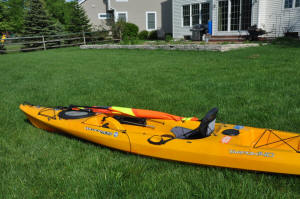
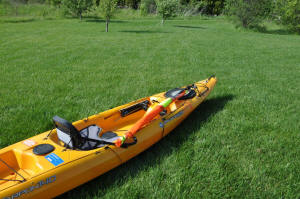
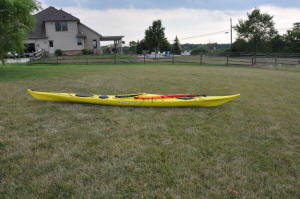
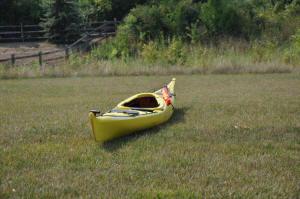
Here is a picture of a Falcon Sail in its compact stowage position.
This option involves removing the top section of the mast before lashing
it down.
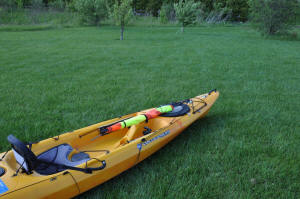
Falcon Sails allow for other depowering options that allow you to keep your sail up but yet reduce your power if you have more power than necessary. You can read about this by clicking here. There is never a benefit of being over powered vs. having the right amount of power.
If you would like to learn more, you can request a copy of our sail tie down kit instructions.
How fast can I go?
This depends a lot on how much wind you are willing to experience. You need to use good judgment. In general, you can go faster with a sail than you can by simply paddling. A sail provides a constant force where paddling is a series on and off pushes. What you will find is that you will go faster and farther than usual, with less work than before. Many times paddle sailors go a lot faster and a lot further with a lot less effort.
At the fast end some experienced kayak sailors regularly report steady 8mph and some times 12+mph surges. This is faster than most small sail boats will go & surely faster than 99% of kayakers can paddle. Kayakers that regularly win races, cannot even come close to keeping up with a average kayaker that has a sail up in good conditions.
It takes some time to build the skill and confidence to go out in conditions that will give top results. Most kayak sailors are very happy with simply going faster than before with less effort and at the same time having more paddling fun than ever. /p>
Do I have to put any holes in my kayak to mount a kayak sail?
For the most solid & simplistic rig you need to drill some small holes for screws (or rivets we provide if necessary on your boat) . Any system of installing a sail that does not have solid mounting points, will not be as good. Some creative Falcon Sail owners have installed their kayak sail without drilling holes. If you drill holes in your boat to install your sail kit, and decide to change something, you can easily patched or plug the hole with a pan head screw ( which we will be happy to send to you if necessary )
What is your money back guarantee?
It's simple. If you are not happy with anything we send to you, send it back to us within 30 days in resalable condition we will give you a refund. If you design a real ugly sail, we may have to talk about it. It is almost unheard of, but if anything breaks during normal usage within the first 2 years, send us the broken part, and we will quickly fix it or replace it for you.
Why would I buy a falcon sail over the other kayak sails that are available?
We obsess over every detail to make the very best rigs available. Our
design, quality materials and workmanship is the best you will find.
Because we obsess over perfecting every detail, we have a lot to tell you
about. It is difficult to keep the explanation short so we made a
webpage dedicated to answering this question. You can see it by going to.
http://www.falconsails.com/WhyBuyAFalconSail.php
What are the advantages of a carbon fiber mast over fiberglass ?
A carbon fiber mast is stiffer, stronger, and lighter than a mast made of an equal amount of any other material. With a carbon fiber mast, your chances of ever having a broken mast is very low. Additionally when the wind blows hard, you get bursts of power and speed rather than a bendy mast that deforms the designed air foil shape of your sail. This is about all you need to know. But we will expand on this a bit below.
Using carbon fiber in a mast is one of the best uses of carbon fiber. The desirability of carbon comes mainly from its strength and ability to not stretch when put under load. This can translate into a mast that is very stiff, and strong.
Carbon fiber itself is only nominally lighter than fiberglass used in the same quantities. Most times when used in sporting goods carbon fiber items are made lighter by using less carbon fiber than would be used if the part where being made out of fiberglass.
If you diminish the amount of carbon fiber used to reduce weight, it can result in parts that are lighter and strong enough to perform like their fiberglass counterparts. Many times this lighter part is noticeably thin and flimsy on some dimensions. A good example of this is the flimsiness you can commonly find when pushing on the hull of a super light boat made of carbon fiber.
When Falcon Sails makes a mast out of carbon fiber, we use the same amount of material as we did in our fiberglass masts. This approach makes the mast a few ounces heavier, but the stiffness and strength benefit is amazing. We have tested our carbon fiber masts against our competition in the compact sail kit group, and have found our carbon fiber masts are 4x stiffer than our closest competition. We also found our fiberglass masts are 2x as stiff as our closest competition. We have discontinued our fiberglass masts because the cost savings (about $25) was very small, and the loss in durability and stiffness is significant.
Our goal is to give our customers the very best kayak sailing experience for the best value. We do not use carbon fiber as an excuse to charge double the price, like is typical with a lot of recreational gear made with carbon fiber. Our carbon fiber mast price over a fiberglass mast is minimal, so the value is significant. We can further reduce our price and order complication by offering our rigs only in carbon fiber.
How much does a falcon sail kit weigh?
Our heaviest largest sail kit including all rigging and sail weighs under 4 pounds. This includes absolutely everything you need to rig your kayak and sail your kayak. The mast, boom, sail, lines, deck plate, mast step, pulley, nuts, screws, washers, pad eyes, cleats, ect. Our 1 meter sail with rigging weigh less than 3.5 pounds in total.
How hard is it to install a Falcon Sail?
Most customers report it takes a few hours to install a sail.
Some people who are very picky and like to tinker take longer.
You
can see a detailed video on rigging a Falcon Sail by
clicking here.
What size sail is best for me?
If somebody asks, we almost always recommend a 1 meter sail. If you are only going to have one size sail, our 1 meter is a great choice.
There are some things to consider before you decide which sail size is right for you. Your weight, your kayaking skills (mostly balance), width of your boat, wind conditions, safety of your sailing environment to name a few.
Even if you only do a limited amount of kayak sailing you will be happy with whatever you decide. A 1 meter sail is the most versatile.
If you are going to do a lot of kayak sailing, more than likely you will decide you want more than one size. In that case a 1 meter sail and a 1.3 meter sail covers almost every situation a normal kayak sailor will choose to go out in.
One great feature of the Falcon Sail design is, you can easily change from the 1.0 to the 1.4 meter sail if you decide you would like more sail. It takes about 2 minutes. You can buy any size sail (without the expense of a full kit) at any time to add versatility to any Falcon Sail kit you have previously purchased. Every size sail has its place for every paddler. The less wind there is, the more reasonable it is to go with a bigger sail. The more wind, the more likely you will like the 1.0 square meter sail over the 1.4 square meter sail.
There are some other factors to consider. It does not pay to be over powered with a sail that is too big. A small sail can push your kayak to hull speed without a lot of wind. Once you are at hull speed, adding power only makes the boat harder to handle and increases your chance of losing control. Being over powered will reduce your progress and make the experience less fun. Our 1.0 meter sail has the greatest wind range where it works well in many conditions. The 1.0 meter sail works very well and is most effective in moderately windy conditions. The 1.0 sail has a taller aspect ratio (which means a taller mast, and much shorter boom) than the 1.4, which gives you more paddle stroke freedom. Some people that are very particular about their paddle strokes will appreciate the 1.0 sail geometry. The 1.4 is a little more likely to get in the way with the boom extending further back towards the paddler.
Here are a few examples of where each size sail has its place.
1 square meter sail- A great choice for any kayaker just getting started with kayak sailing wanting a versatile sail for most conditions.
- A 160 pound person with a 22" wide kayak buying their first kayak sail.
- A lighter person with a 30" wide recreational kayak.
- A very experienced kayak sailor looking for their prime sail to use in windy conditions.
- Any kayak sailor wanting moderate sail area, and would like to keep the boom more away from their paddle stroke.
The 1.0 sail is by far our most popular, and is the most versatile size.
1.4 square meter sail- Most paddle sailors looking for a very light wind sail that are expecting an assist rather than primary propulsion.
- An experienced paddle sailor looking for a harder push in moderate conditions.
- A newer paddler looking to go paddle sailing only in very light conditions.
- A kayaker with a wide stable boat.
- A kayaker that does not care if the boom some times gets in the way.
- A paddler using a boat with outriggers.
Typically if a paddle sailor would have 2 sails, this would be a great second size to have.
How do I reef my sail?
Reefing is one of many traditional sailing methods to reduce effective
sail area / depowering to make things more manageable. There are a lot of
factors to consider when evaluating if there are any practical / net benefits
in reefing a kayak sail. Overall, reefing a kayak sail is a waste of time,
just like reefing a wind surfing sail is ineffective. After reviewing
all the factors involved, it is easy to see reefing mechanisms on small
kayak sails are a marketing tool that causes more problems than they solve.
Sail makers would better serve their customers by providing simplistic,
predictable sails without extraneous hardware. If you are not in control,
its time to lower your sail.
Read on for a more detailed answer.
There are better ways to reduce the power of your sail. Falcon
Sails give you the
ultimate
tool for reducing sail power. You can lower your entire sail rig
from your seat, eliminating its effect completely, in just a few seconds.
Read below about
practical
depowering tools and methods available with a Falcon Sail rig.
Reefing a kayak sail sounds great in theory, but in practice, it is problematic
and gives little overall benefit. Reefing a kayak sail involves bunching
sail material on the mast. Reefing on conventional / typical sail
boats is done by lowering the sail along the mast and tying excess material
on the boom. When sail material is bunched up on the mast, the first
thing the wind will hit is a wad of material rather than an aerodynamically
shaped mast pocket followed by the sail. Once you reef by placing
a wad of material on your mast, your sail will go from reliably converting
heeling force into propulsion, to heeling force acting as heeling force.
It also makes the sail less consistent and predictable.
Reefing by
wadding material on the mast also increases the height of the sail's center
of force rather than reducing it, as happens with reefing traditional sail
boat sails. Raising the height of the center of effort is exactly
the opposite of what your goal is when reefing. This is not desirable.
It is far better to use a kayak sail size that will not get you into
trouble. If you are looking for maximum power and an option to depower,
an ideal plan includes using a rig that allows you to easily change sails
sizes rather than having a plan to destroy your sail shape by wadding material
at the mast. Falcon Sails can easily be changed allowing you to pick the
right size for the conditions. Most paddle sailors feel well covered by
carrying a 1 square meter and a 1.4 square meter sail. Some will carry a
.7 square meter sail as an option as well. In the rare situation where
you make the commitment to go some great distance with no landing options,
you should choose a sail size you are confident will not be too difficult
to control. If you go smaller than necessary, it will never be a major loss.
If your sail is too big for the conditions, it's time to lower your sail.
A kayak sail reefed to match the size of an even smaller sail will be significantly
less efficient, much harder to handle, and less safe than a smaller sail
to start with.
When it comes to reefing kayak sails, there are several significant issues. One problem with reefing a small sail is it will ruin the air foil shape. For example, wind surfers never reef their sails. They choose their sail for the conditions. Larger sails on conventional sail boats reef okay, but small sails do not reef well. This is even truer if the sail is made of desirable (crisp and stiff) sail cloth. Anybody racing any kind of boat will almost always change sails rather than reef. This is true even on conventional sail boats where reefing provides meaningful net benefits. Wind surfers use sails similar to kayak sails with similar material. It is unheard of for wind surfers to reef sails. The reasons for not reefing become more significant as the size of the sail decreases. When you reef a small sail, your air foil shape is pretty much gone and the sail area you eliminate turns into a wind catching blob. A wad of material at the mast, can create more problems than it solves. It also tends to put unnecessary creases in a crisp sail which is better to avoid.
Another problem is that reefing is a mechanically awkward process. An awkward process is not what you want when you are concerned about your control of the situation. Additionally, reefing mechanisms, even if not used, add weight, bulk, expense, complication, and get in the way of the main goal of a sail; which is to provide an effective and efficient air foil. This weight, bulk, complications, and inefficiencies impact 100% of your sailing time, and rarely if ever provide great benefits. The cleaner your rig the better.
Some kayak sail makers opt for the extra weight and complication that
allow reefing by wrapping a sail around the mast. This method involves a
lot of hardware and leaves a large blob up high. This leaves windage up
high with no benefit. With this system, the best you can do is completely wrap the
sail around the mast and live with the substantial weight and wind catching
area aloft. If you have to paddle straight upwind, in heavy wind, this is
very undesirable. Other kayak sails make reefing systems that pull one batten
toward the mast. When this is done, it raises the center of effort,
which creates other sailing issues.
If you look at a traditional
(non kayak sail) reefing systems, they always pull the sail down a bit and
reduce the height of the sail at the same time. It also does not impact
the air flow of the leading edge of the sail. This brings the center of
effort down, rather than up. This can be done with a traditional sail
because they slide up and down the mast which allows for the sail to be
partially lowered in order to reef. It can also be done beneficially
on dedicated sail boats, because the sails are much larger, and creases
created when folding are a much smaller % of the reefed sail over all.
It is time to reef when you feel as though you can be more efficient
with less power. If you have a reefing method that kills your sail's
good shape, it may make you feel more comfortable, but the reduction in
shape efficiency makes it not so worth while. In the rare situation
you feel overpowered for safety reasons, you should simply lower your sail
and secure it to your deck, rather than mess with the complications involved
with reefing a sail on a kayak. With a Falcon Sail, you can secure your
sail on your deck and completely eliminate the complication of a sail, in
seconds.
If you look at many pictures of conventional sail boats under sail, you will notice it is unusual for reefs to actually be used. Even if you can eliminate all the drawbacks to reefing kayak sails, the number of times it would be beneficial is very limited.
If you have any doubts about an outing, go with a smaller sail. Then you will have a very easy to handle rig that will be much more efficient than wadding up a small sail to make it even smaller. Or mitigate the risks by staying close to safety and use that day for increasing your skills in handling a lot of power. Having skills in handling a lot of wind power, is a lot more effective than wadding up a small sail to make it smaller and less efficient.
Just like in wind surfing, it is good to have sails of different sizes to choose from for different situations. Falcon Sail rigs will quickly accept any size of Falcon Sail made so you can easily change from one sail size to another. With some experience and reasonable judgment, it is very easy to make smart sail size choices. Most times kayaks are not far from shore. In the rare situation you make a size choice where the sail is too small, it is not a major sacrifice to live with it till you go to shore. In the rare situation you feel over powered, stow your sail and then change it when you get to shore.
Other sail depowering methods
Another great option is to use other conventional depowering methods.
You can #1) simply let the boom out more than usual, and or #2) disengage
your boom vang. A good sail will have a boom vang. A boom vang holds the
boom down so the sail is exposed to as much wind as possible. Having a
boom vang allows a smaller sail to provide as much power as a lager sail.
If you have a boom vang you can use a smaller and easier to control
sail and have the same amount of power. You can also loosen your outhaul.
A good sail will also have an adjustable outhaul. An outhaul allows you
to stretch your sail out, to provide the maximum amount of useful surface
area & has benefits similar to having a boom vang. These adjustment
methods can give you a comforting degree of depowering without destroying
the airfoil shape of your sail. Reefing mechanisms on kayak sails end
up putting a wad of material for the wind to catch rather than the air
foil preserving tools and methods available on a Falcon Sail. A streamlined
air foil shape is easier to handle and more predictable than a wad of
material. A good air foil shape turns heeling force into propulsion. A
wad of cloth simply creates something for the wind to catch and make you
uncomfortable when your goal is to be more comfortable.
In the
rare situation, you feel as though you cannot control your boat, the smartest option is to just take your sail down. You can take a Falcon
Sail rig down and securely stow it in seconds.
If you are dealing with an overpowering tail wind, you will be moving fast enough on your own without the added push from a sail. If you have a cross wind and things are out of control, it is best to just paddle. If you are going upwind, a reefed kayak sail is completely useless anyway.
The four Falcon Sail depowering methods (loosen the boom vang, loosen the outhaul, loosen the sheet line, and lower the sail ) noted above are always easier to take advantage of than the simplest reefing systems. Three of the four allow for a proper shape that is much easier to handle than wads of material created by reefing a small sail. The last resort option is simply lowering and stowing your sail in seconds. This 100% eliminates the complications of having a sail catching wind. Stowing your rig is an option you really should use if you are pushing your limits.
In the end, the most important thing to know is if you feel you may
lose control, it is time drop of stow your Falcon Sail.
Do I need a center board or lee board to properly sail a canoe or kayak?
A standard kayak hull is all you need to efficiently sail a kayak. See our answer to "What direction can I sail in relation to the wind?" question below. Falcon Sails are all designed for boats with no lateral resistance appendages (center boards, dagger board, lee boards, keel, ect). Falcon Sails does all its testing without these appendages. As a matter of fact, nobody that tests for Falcon Sails use any of these things while kayak sailing. Any statements of performance you find on this site are based on standard kayak hulls.
These appendages take away from the freedom, simplicity, and lightness that can only be had by boats without these complications. All hulls have a level of lateral resistance. The faster a boat moves, the more lateral resistance it has. This is especially true for kayaks because they are designed for tracking. Tracking means going in a straight line, which is achieved by designing lateral resistance throughout the length of the hull. A byproduct of a tracking design goal is a hull that tends to go forward but not sideways. At the front of a kayak where the hull cuts into the water there is even more lateral resistance to movement. More lateral resistance at the bow of a kayak is great for kayak and canoe sailing because the most convenient / practical place to mount a sail is forward of center. One goal for any sail plan is to balance the center of lateral resistance of the hull in the water with center of lateral force created by the wind hitting the sail and the rest of the boat above the water line. This way the sail & hull combined create a balance of not turning into the wind or downwind. The combined lateral wind force on a kayak with a sail, and the lateral resistance of a kayak hull are surprisingly well balanced.
Dedicated sail boat / typical sail boat hulls are made to provide as
little resistance to movement forward through the water as possible. A
byproduct of designing a sail boat hull to be slippery as possible
going forward is a hull that is slippery in all directions that will
not track / tends to spin. So a
conventional sail boat hull without a keel is very slippery in all directions
including sideways. Without a rudder and a keel
(or other lateral resistance appendage) a sail boat hull tends to
easily move sideways and
spin. Its hull is designed for maximum efficiency not tracking. Except the keel or centerboard,
there is very little lateral resistance in a typical sail boat hull. A
sail boat hull (with a centerboard up) will slide sideways even without
the sails up. This makes lateral resistance appendages critical in
a sail boat hull. These things are not true with kayak hulls. The design goal of a kayak is more for tracking. Tracking
goals are addressed by adding lateral resistance throughout the hull length.
Kayak hulls have much more lateral resistance than a sail boat hull without
a centerboard or keel. One reason sail boat hulls have centerboards or
keels added because their hulls do not have built in lateral resistance
like a kayak hull does. Additionally a boat dedicated to sailing, that
stays at a dock or is moved with a trailer can afford to have the weight
and complication. If your kayak had a hull like a sail boat hull with
no centerboard, it would slip sideways in the wind to a frustrating degree,
even without a sail. Since tracking is a major design goal in a
kayak hull, they have a decent amount of lateral resistance without having a extra
appendage hanging down
in the water. Every kayak has an ability to track.
To further
make this point imagine a kayak in the water with an adult sitting in
it. Now push that kayak sideways and think about how far it will
glide sideways. It will stop moving sideways, about as soon as
your hands are off the kayak. Next push this kayak that has an
adult sitting in it forward. Most kayaks will easily glide over
30 feet and more. This example shows a kayak has ay more
resistance going sideways than it does going forward. This is
very similar to how a conventional sail boat performs.
Another
interesting fact about keels and center boars and lee boars, is until
modern boats came about, they were not common. Historically,
lateral resistance appendages, were not common a lot because the hulls
that existed before todays modern hulls, had a reasonable amount of
lateral resistance much like you find on kayaks today.
A modern sail boats hull drag is much lower than a kayaks, which
is great in a sail boat for light wind days, but this characteristic creates a need
for lateral resistance appendages on sail boats. In a kayak you always have
convenient power so this perfected efficiency with little lateral resistance
has much less value / is not worth a boat that spins, slides sideways,
or adding a big bulky appendage that has its own drawbacks.
The amount of lateral resistance benefit a keel, lee board,
or center board provide to a canoe or kayak is more than offset with significant
sacrifices, including weight, bulk, complication, drag and expense. Standard sail
boats that have raise-able centerboards are raised on many points of sail
to reduce drag. There are times increasing your lateral resistance could
help if you consider no other factors, but overall they are a true drag
on the overall performance of a kayak or canoe. Upwind tack lateral resistance
issues can be mostly addressed simply by paddling to keep the bow pointed
on course into the wind. One last reason to skip the lateral resistance
appendages is to stay within the rules for some classes of adventure races.
Some race rules allow sails in kayak classes but do not allow lateral
resistance appendages.
Even with all these arguments in favor of skipping lateral resistance
appendages, you can still rig one if you like. We suggest you
give kayak sailing with out them a try, and then decide if you want to
add this kind of a contraption to a simplistic sailing kayak option.
In this video you can see a Falcon Sail on a kayak with no lee
boards, or dagger boards, or center boards or any other lateral
resistance enhancer, and see easy sailing with no paddling 210 out of
360 degrees.
https://youtu.be/e-IxDPoadjU
With a little bit of paddling, you can increase the 210 degrees
quite a bit. When you become a good sailor, you can gain
useful sailing propulsion to within 30 degrees of straight up wind.
That ends up allowing you to have sail propulsion on 300 out of 360
degrees.
What direction can I sail in relation to the wind?
You can make up wind progress with a Falcon Sail. The short answer
is you are paddling / paddle sailing you can gain useful sail
propulsion on 300 degrees out of 360 degrees. If you want to do
zero paddling, you can still sail 210 out of 360 degrees. This answer requires some detail to fully
explain.
To show you what you can do with about zero paddling,
watch this video. It shows a Falcon Sailor doing very little
paddling able to make up wind progress with a totally normal kayak
hull. It is actually a rounded bottom hull which is not as good
as what a contoured V shaped and hard chined hulls are. All
kayaks sail pretty well so do not get hung up on hull shape.
https://youtu.be/e-IxDPoadjU
Many compact sail makers loosely say you can reach ( sail within 90 degrees of straight upwind ) with their sails. Reaching means you have 180 degrees of potential travel. Some that say this may be correct. Others just get the feeling they are reaching as they go and they say they are reaching. Really they are being blown downwind.
We have tested all the most popular compact sail kits on the market, and they all fall short of actually reaching. Reality is some that claim to reach are not reaching, and those that may be reaching ( sailing within 90 degrees of straight upwind ) are still falling way short of what a Falcon Sail can do ( potential of providing useful propulsion up to 30 degrees of straight upwind) . Any sail that is at or near its limits will eventually stop providing advantages. If our competition is at their theoretical 90 degree limit, a Falcon Sail is well within its sweet spot. Our best competition is slowing way down or completely stalled at 90 degrees to the wind. If a Falcon Sail is well within its range and another makers sail is near its limits, the Falcon Sail will be much faster, maneuverable, and easier to handle. What this means is at nearly all points of sail the Falcon Sail will be more efficient than any other compact sail kit available today.
- Falcon Sails determined its ability to sail upwind based on actual movement (not just what direction the boat is pointing) determined by gps.
- These figures are determined when paddle sailing kayaks that have no centerboard, lee board, keel or any other special appendage. (These are completely standard hulls)
- We use the best methods we have available to make these calculations.
You cannot determine your ability to sail upwind based on what direction your boat is facing in relation to the wind. All boats ( including those with a centerboard, keel, dagger board, lee boards, ect ) are pushed downwind from where it is actually pointing. Especially as you are attempting to point your bow into the wind. In practice a gps is needed to determine the precise direction you are actually traveling.
Without precise wind direction measuring equipment on a steady platform you can not accurately measure the direction of the wind. On a kayak you can only determine the general direction of the wind. With a gps and indirect method you can determine the direction of the wind when you are paddle sailing a canoe or kayak.
With the following test you can determine your rigs ability to point into the wind.
First you sail as much into the wind as possible on one tack & take a reading of your actual course. Then tack to put the wind on the other side of your boat and try to sail into the wind as much as possible & take a reading of your actual course again. The difference between the 2 course readings is the range you can not sail in. Your course in degrees is available on most gps devices.
The angle you can sail in relation to the direction of the wind determine what courses are available to you when sailing. When all variables are ideal, you can paddle sail a Falcon Sail 300 of 360 degrees of potential travel. By tacking you can effectively make headway straight upwind. Tacking upwind can be fun and is great practice to make you a better paddle sailor on all angles of attack. Once you are well practiced, a Falcon Sail kit gives you the potential to paddle sail 300 out of 360 degrees of potential travel. That means 5 out of 6 potential courses.
- Quality of your sail and rigging. You need to have a proper air foil shape, stiff cloth, stiff mast, and solid rigging. Generally speaking this means a well built single mast rig with an air foil shaped sail. Falcon Sails are made this way. A Dacron sail with a carbon fiber mast is the best combination for maximum performance.
- Strength of the wind. The general rule of thumb is the more wind there is the better the rig will perform. This is especially important as you are trying to point into the wind.
- Skill of the paddle sailor. Anybody who can paddle a canoe or kayak, can paddle sail / have fun and take advantage of paddle sailing. With a good rig anybody can paddle sail to windward. If you want to squeeze the very most performance out of your rig, experience helps. You need to set the sail at the right angle, lean downwind, keep the bow pointed in the right direction, and take advantage of wind shifts and gusts. A beginner will loose 15 or so degrees on each tack compared to a experienced paddle sailor that is concentrating.
- Are you paddling. In order to paddle sail the maximum amount into the wind, you must be paddling. Otherwise you can not keep your bow pointing in the right direction. You can sail up wind without paddling, but you will loose quite a few degrees of upwind performance. When you are paddle sailing into the wind, you are traveling faster than you would if you where only paddling the same course.
- Size of your sail. If your sail is too big, for that days wind, a smaller sail will help you perform better.
- Size, frequency, and steepness of waves. Waves are a lot of fun. They can make you go faster on many points of sail, but when you are focusing on upwind performance, waves are typically counter productive. When you peak over a wave the canoe or kayak tends to be pushed down wind. If you are trying to push your sails limits for upwind performance it is best to be on a smaller lake and or be in a situation where the wind is blowing off shore and there is very little fetch for waves to build.
- Steadiness of wind velocity wind. Steady wind is always easier to deal with. Especially when you are trying to maximize upwind performance. Though gusts can be taken advantage of by "diving the bow to windward".
- Steadiness of wind direction. Steady wind direction is easier to deal with. Though an alert sailor can take advantage of wind direction shifts & change tacks to increase the velocity to the destination made good. This changing of tacks following wind shifts to increase the velocity made good is not part of our calculation of upwind capability.
- Are you moving already? Just like all other sailing craft you must be moving in order to start sailing into the wind. You have to be moving and then turn into the wind. You can not just aim your bow while not moving at low angle to the wind and expect to start moving. You have to start at a more downwind angle if you are not moving and then turn into the wind. This is called falling off in the sailing world.
Here is a video that will give you a idea of what you can do with a Falcon Sail
Can I use one sail on more than one boat?
Yes. All you need is a extra boat kit. An extra boat kit
includes everything you need to solidly rig your Falcon Sail on
another kayak or canoe.
An extra boat kit, will also allow you to
move your Falcon Sail rig from one boat to the other with just 1
minutes effort.
If you would like an extra boat kit, send us an
email telling you want an extra boat kit. We will email you an invoice
that you can pay on line.
As of writing this, we charge $80 for an
extra boat it.
An extra boat kit includes a deck plate, under deck
plate, mast compression strut, hull reinforcement patch, sail
tie down kits, cleats, fairleads, and all the fasteners you will
need.
It also includes a junction ring along with mast standing
lines and stainless clips so your additional boat can have custom
adjusted lines which allows you to change your rig from one boat to
the other in just one minute.
How much rigging / setup does a falcon sail require at the put in, and take out?
If you leave your sail on your boat between paddles, there is no rigging required. If you need to rig your sail on your boat each time you paddle, you can put a rig together in 60 seconds and remove it in even less time. If you race to put a rig on and off quickly you can put the sail on in 30 seconds, and take it off in less time.
Can I leave my sail on my boat all the time so I do not have to put it on and take it off when I use it ?
You can leave your sail on your boat all the time. Though it is a good idea to hang your sail just like you would your fine clothing. You should also not leave it on if you are doing lengthy express way driving. In any case you can take your sail off an put it in the bag that is provided with every rig in about 1 minute, so you might as well take it off when you are done paddle sailing.
What maintenance does a Falcon Sail require?
Very little maintenance. Just keep sand and mud out of the joints, and your kit will last for a very long time. If you do get mud or sand in any joints, just use water to clean it out. Like any sailors some canoe and kayak sailors like to clean their sails. Just use a mild soap with water and a gentle brush to clean off any dirt that you may have gotten on your sail. Let the sail air dry.
Will the Falcon Sail hardware be able to stand a salt water environment?
After years of research, destructive testing, extensive customer use, obsessive continual refinement, our rigs are about impossible to break or wear down or damage due to exposure with reasonable use. You can break our rigs with a hammer, or maybe harm the actual sail by leaving it exposed to intense sunlight for an unreasonable amount of time. Our hardware is all made of stainless steel, hard anodized uv protected aluminum, Delrin, carbon fiber and epoxy. Falcon Sail rigs have been exposed to a saltwater environment continually for many years and stand up to it with no problems. If there is ever a problem, with a Falcon Sail rig, let us know, and it will be replaced. But do not worry, Falcon Sail rigs will last a life time.
What colors are available?
Falcon Sails has created a color selection in high quality 3.8 ounce Dacron that is simply amazing. You can choose your color for ever panel on your sail. All the color variations available for every panel add up to Billions of potential color combinations. See our designer by clicking here.
How do I attach a falcon sail to my canoe or kayak?
The most common way to attach a Falcon Kayak Sail to your Kayak or Canoe is to use our patent pending deck plate, car, and mast universal joint that comes with our kits. It is very easy to use. The pictures below show how easy it is to slide the mast base onto the deck plate. If you have access under the deck we provide screws. If you do not have access under your deck we also provide the correct rivets to attach the plate and all other parts necessary. See a picture of our updated hardware in the bottom picture. All kits sold after August 2012 comes with this type of mast base. The rigging process is the same.
Our customers have done other kinds of installs. If there is something different you would like to do, let us know and we will try to help you. You can learn more at or install instruction by clicking here or by clicking here for our picture page.
Will a Falcon Sail work on a inflatable canoe or kayak?
If you are determined to make it happen and have some mechanical skills the answer is yes. It is not a standard installation, and will require you to improvise. Rigging for a inflatable kayak is not part of our standard kit. Our kit is not designed specifically for this kind of boat, but we find that our users are constantly installing our sails on different kinds of boats in creative new ways.
As always we will be happy to provide some help to our customers with anything they want to try. We will help you with inflatables but you are on your own and will have to make it happen yourself. If you are not determined, mechanically inclined and patient this is not a good ideal.
The below pictures are 2 of our customers with a inflatable kayak that rigged a sail on them. Both reported a very good experience. One some wood to make a cross member, and the other used cheap pvc pipe bought from a Home Depot like store and glued this rig together. We do not consider pvc to be a absolutely great method of installing a sail on a inflatable kayak, but this does show one line of thinking. There are many ways to make it happen. It will require some thinking and maybe trial and error.
Will you ship to over seas locations?
Yes. We sell sails and sail kits all over the world. Add your item to the cart to see the shipping cost.
What is next?
We are just getting started. Right now we are working on refining our designs, production, building up inventory, and speeding up delivery times. We will only do things directly related to kayak sailing.
